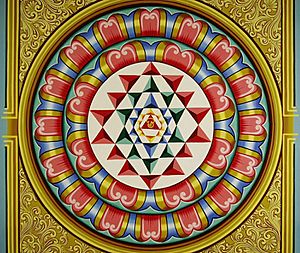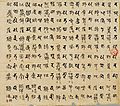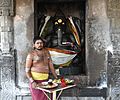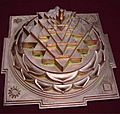Tantric yoga facts for kids
Tantra is a special spiritual tradition that started in India over a thousand years ago. It's a way of life and a set of practices found in both Hinduism and Buddhism.
The word "Tantra" can mean many things in Indian traditions. It can refer to a specific text, a way of thinking, a system, a method, or even a tool or technique. A very important part of Tantra is using special sounds or words called mantras. Because of this, these traditions are often called the "Path of Mantra" in Hinduism or the "Mantra Vehicle" in Buddhism.
Contents
What is Tantra?
Tantra is a spiritual path that helps people grow and find inner peace. It involves different practices like yoga, meditation, and using mantras. It's about understanding the world and yourself in a deeper way.
Tantra in Buddhism
In Buddhism, the Vajrayana traditions are well-known for their tantric ideas and practices. These are based on special Buddhist texts called Tantras. You can find these traditions in places like Tibet, China (called Chinese Esoteric Buddhism), Japan (called Shingon Buddhism), and Nepal (called Newar Buddhism). Even though some other Buddhist traditions in Southeast Asia don't use the word "tantra," their practices are quite similar.
Tantra's Influence on Other Religions
Tantric ideas from Hinduism and Buddhism have also influenced other spiritual paths in Asia. These include Jainism, the Tibetan Bön tradition, Daoism from China, and the Japanese Shintō tradition. This shows how widely these ideas have spread and been adapted.
Tantra in Daily Life and Art
Many ways of worship that are not part of the very old Vedic traditions in India are considered tantric. For example, Puja, which is a devotional ritual, often follows tantric ideas. Even the way Hindu temples are built and decorated often uses symbols and designs from Tantra.
Special Hindu books that talk about these topics are called Tantras, Āgamas, or Samhitās. In Buddhism, Tantra has greatly influenced the art and symbols you see in Tibetan and East Asian Buddhist art. It also shaped the ancient cave temples in India and the art of Southeast Asia.
Images for kids
-
An illustration of a yogi and their chakras.
-
The Brihadishvara Temple, a temple in Tamil Nadu.
-
A Kali Puja (devotional ritual).
-
A Pujari in front of a Ganesha statue at the Brihadishwara Shiva Temple.
-
Sri Yantra diagram with the Ten Mahavidyas.
-
The Sri Yantra (shown here as Sri Meru or Maha Meru).
















